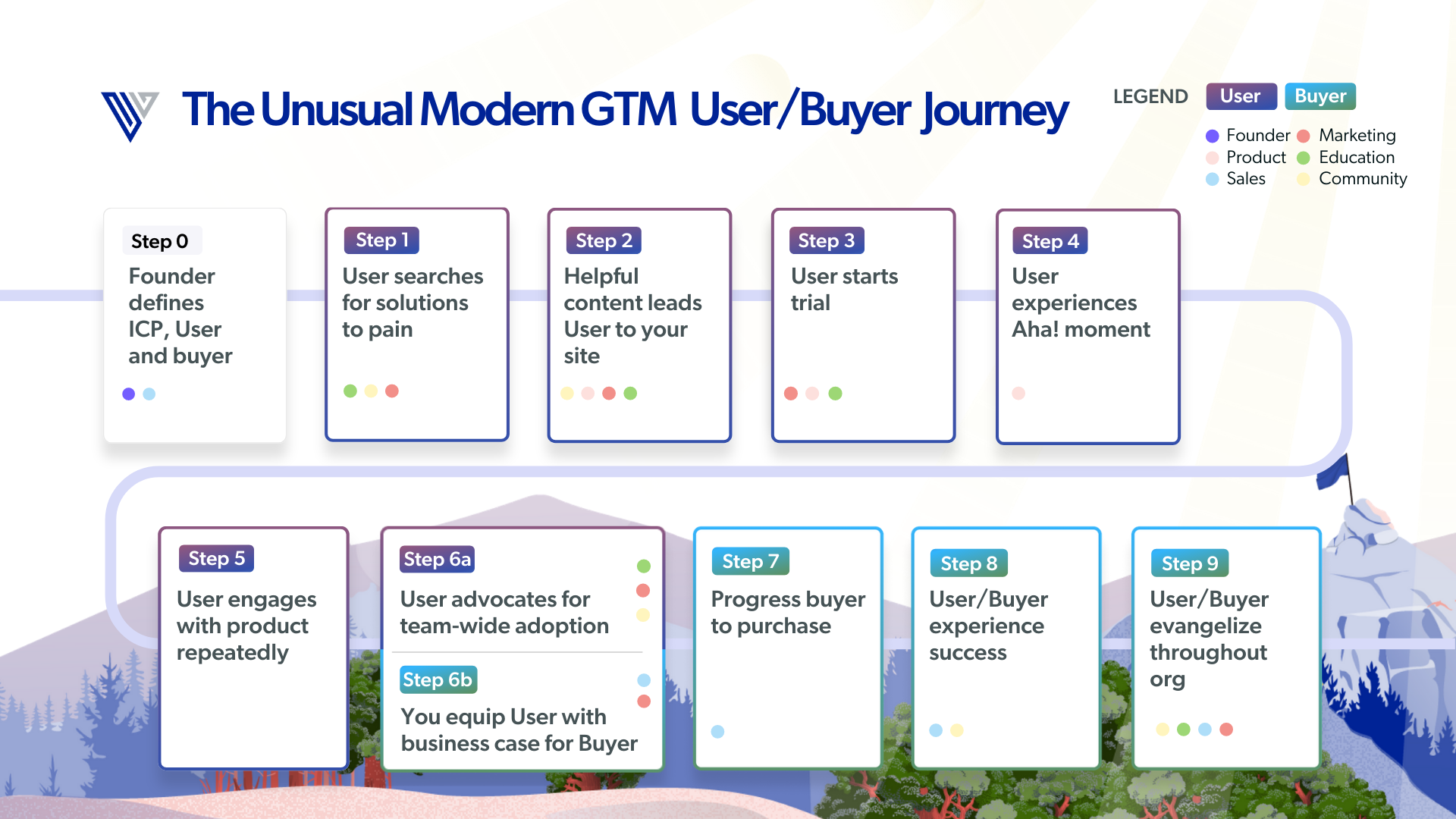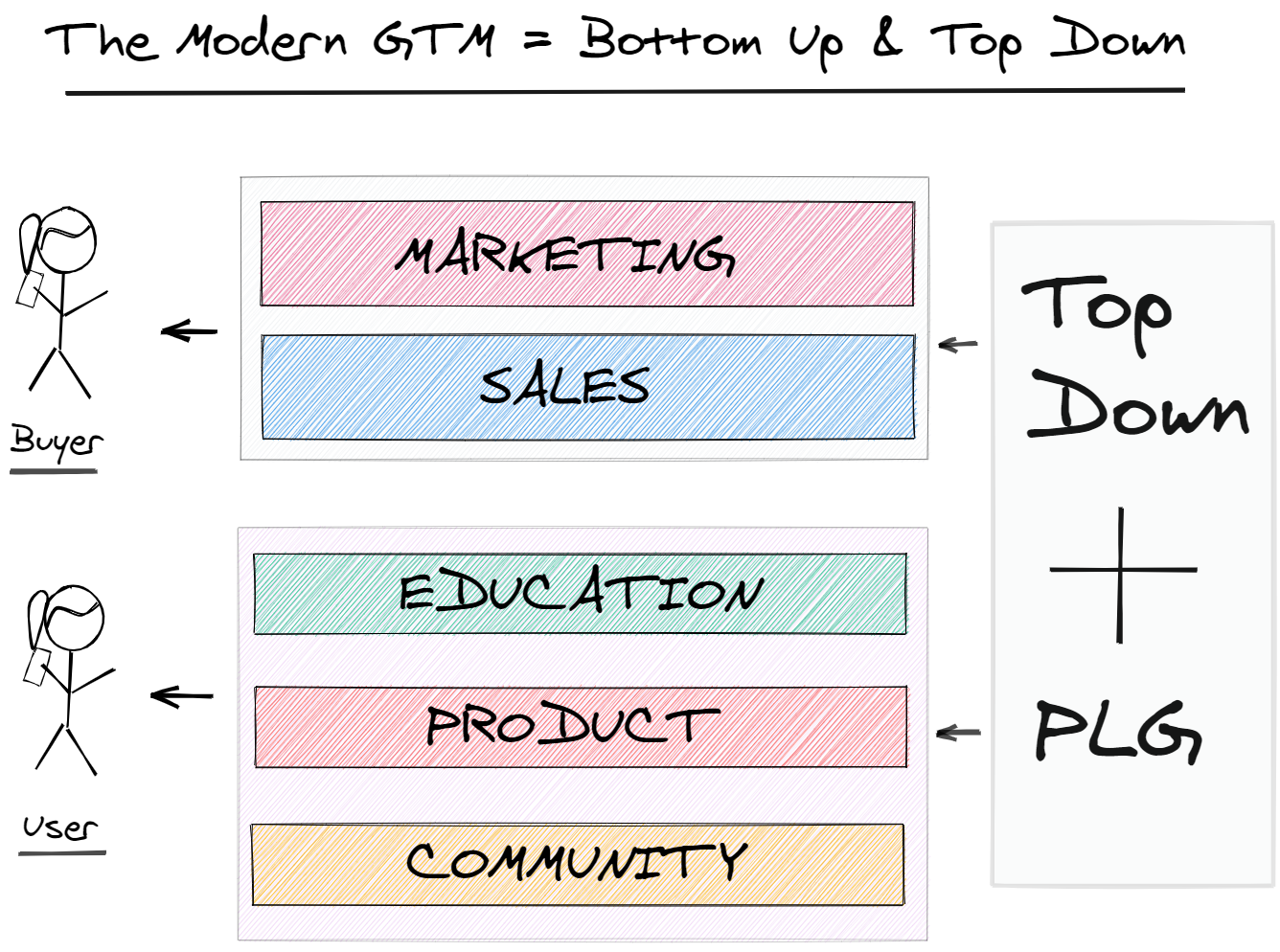
The Unusual Ventures Modern GTM USER/BUYER Journey diagram is a framework for founders and all functional leaders in a startup to:
One of the most important fundamental changes in the Modern GTM vs. the old GTM model for enterprise startups is creating specific steps and action items for two distinct personas: the USER and the BUYER.

As we discussed in Understanding the Modern GTM for early-stage founders, in the old GTM motion, the BUYER was the most influential person in a sales decision and, logically, was targeted by marketing and sales teams. Buying was a centralized decision, with power strongly concentrated in the C-level executive suite.
Today, the buying process for enterprise software is largely decentralized, meaning individual USERs have the authority and agency to research, select, and purchase solutions. This means that the Modern GTM for enterprise startups must focus on the needs of the USER first, and only after the USER is satisfied and converted to a solution champion, should the process to engage the BUYER begin.
As illustrated in the Modern GTM USER/BUYER Journey map, steps 1–6a are focused on the USER. In our framework, USERs have a specific hierarchy of needs and a behavior pattern that founders must understand. At Unusual Ventures, we believe strongly that USERs prefer a self-service approach to finding and using new solutions in enterprise software. While not 100% accurate for every USER type, the following series of steps is one we commonly see:
A successful Modern GTM motion nurtures a high percentage of USERs from Step 1–Step 6a — and does so efficiently. This requires a highly collaborative effort from the startup and its marketing, education, product, and community functions (as noted by the colors in each step on the USER/BUYER Journey map). The founder must orchestrate these efforts and provide goals that drive alignment among the various teams.
At Step 6a, the USER is now a champion of your solution, so the BIG money just starts rolling in right? Unfortunately, the answer is usually no. While USERs can sometimes be the initial purchasers of solutions, and even lead the charge on expansions, it usually turns out, no matter how amazing the product is, that salespeople need to be hired to close larger deals. I am not suggesting there aren’t exceptions, but generally speaking, founders should plan to hire salespeople.
It is at Step 6b that the concept of a BUYER is introduced in the Unusual Modern GTM USER/BUYER Journey map. In the Modern GTM, the educational content, free product experience, and community support earn the startup the opportunity to engage in a sales process. Appreciating this point is essential for any founder building a Modern GTM startup.
We recognize that for some startups, the BUYER can be the same person as the USER. It can also be the case that these are two, very distinct human beings. Whatever your situation, as a founder it is critical to understand that the motivations for using your solution are different than the justifications for purchasing your solution. And this means you need marketing material and engagement processes to optimize both. In Steps 6b–9 of the Journey Map, sales is the primary driver at each step and is supported at times by product, marketing, community, and education.
Founders occasionally ask, “Isn’t the Modern GTM just product-led growth (PLG)?”
In our view at Unusual Ventures, the simple answer is, “No, PLG is a component of the Modern GTM.”
To be clear, we are huge believers in PLG, and we have a thorough module we will publish in the coming weeks. We consider PLG an essential component of the Modern GTM and something founders need to learn about and master (see Intro to product-led growth).
In our framework, PLG consists of the education, product, and community functions and is organized around the USER in our Journey Map.

One way we see founders get tripped up is when the term “PLG” is used synonymously with “bottom up” to describe the strategy for GTM. At Unusual Ventures, we often describe the Modern GTM as a process that deploys a “sandwich” or “pincer” strategy when it comes to engaging with a prospective customer when we explain the reality of successful execution. By this, we mean that the Modern GTM includes both PLG and top-down execution. The combination of the two enables a startup to successfully engage with both the USER and the BUYER personas throughout the Journey Map.

USER: Through great educational content, a tuned free product experience, and a managed community, the PLG motion engages USERs and builds a universe of potential customers to convert. A PLG motion done well earns a startup the right to engage a customer with a legitimate sales process.
BUYER: For deal sizes in excess of $30K (U.S.) in annual contract value (ACV), we almost always experience the need to engage a more senior member of the organization (simply as a result of purchasing authority bands in most companies). One of my mentors likes to proclaim, “Sales is not a debate, it is a seduction.” To win over BUYERs requires human-to-human engagement and the supporting material and process to go along with it. This is what we call “top-down” in our framework.
The ultimate goal of a Modern GTM executed well is that customer acquisition is done in the most efficient way possible. Through the successful execution of a PLG and top-down motion, sales representatives, who are oftentimes a startup’s most expensive resource, are utilized in the optimal way as they engage only with prospects who have self-identified as repeat USERS of the solution. As we tell our Unusual Academy participants when diving deeply in this area: “It’s a lot easier to sell Bibles to the converted than trying to get people to go to church.”
For founders who successfully build a startup with a Modern GTM, they can expect higher sales conversion rates, less capital required to scale a business, and less dilution for employees. Everyone wins!